Legal Methods Module: Statutory Interpretation in the UK
VerifiedAdded on 2020/06/04
|8
|1851
|41
Report
AI Summary
This report delves into the methods judges use to interpret statutes within the UK legal system. It begins by defining statutory interpretation and highlights its importance, particularly when ambiguity arises in legislation. The report then outlines key methods, including the literal rule, golden rule, and mischief rule, explaining their application and limitations. The literal rule emphasizes the plain meaning of words, while the golden rule provides an exception to avoid absurd outcomes. The mischief rule focuses on identifying the problem the statute aimed to address. The report also discusses the purposive approach, which considers the purpose of the legislation. The Council of Civil Service Unions v Minister for the Civil Service (GCHQ) case is used to illustrate the application of these principles, particularly concerning judicial review and national security. The report concludes by emphasizing the judiciary's crucial role in interpreting laws and the significance of these interpretation methods in applying statutes effectively.
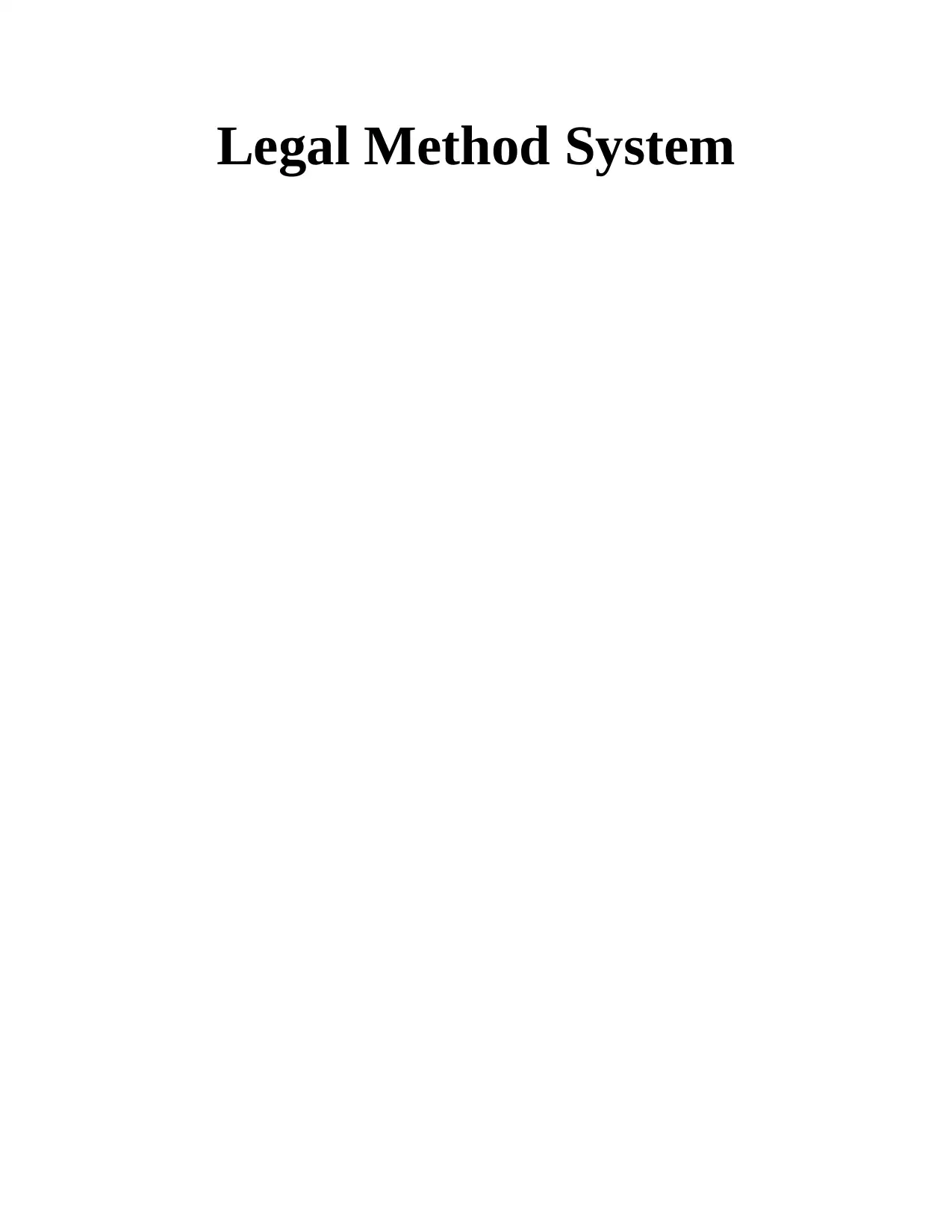
Legal Method System
Paraphrase This Document
Need a fresh take? Get an instant paraphrase of this document with our AI Paraphraser
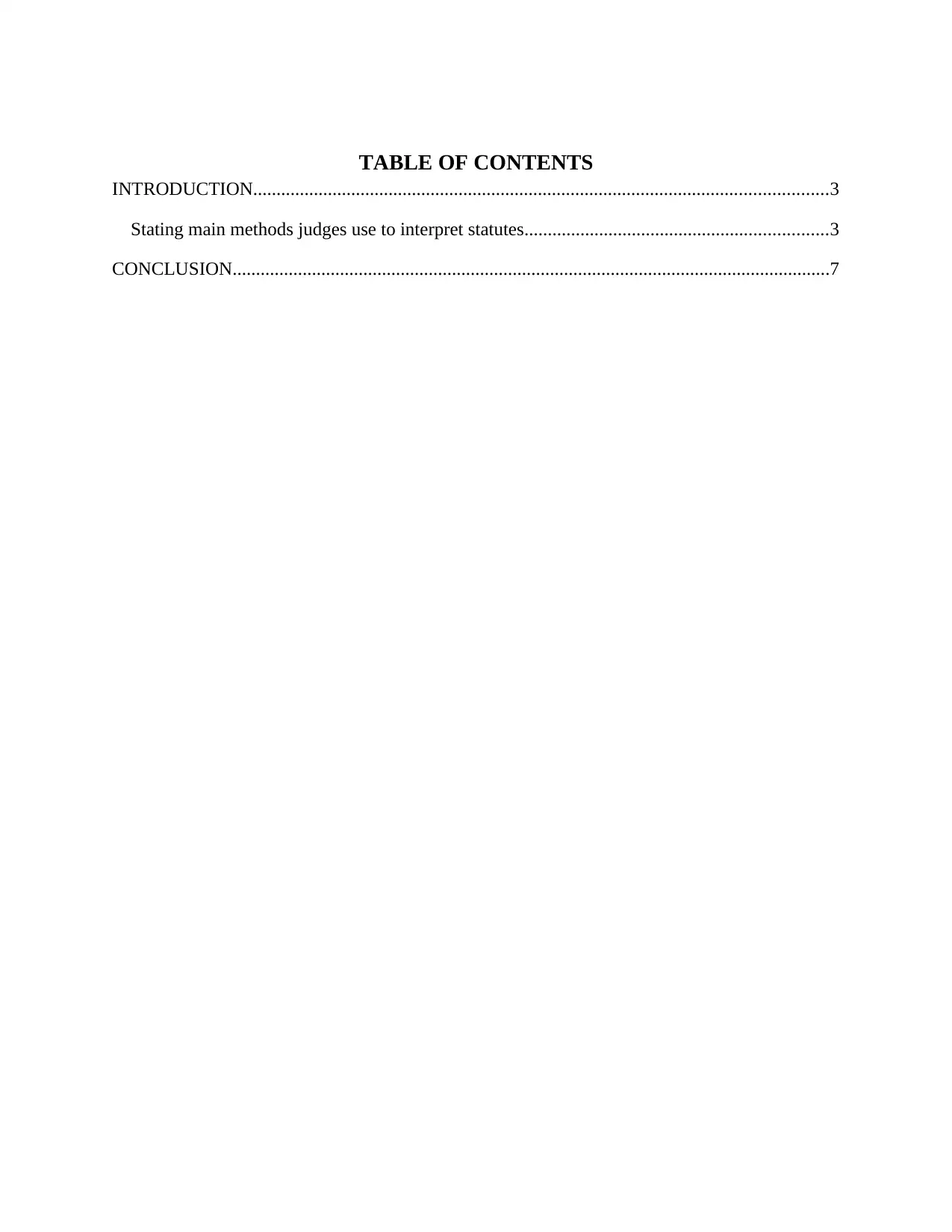
TABLE OF CONTENTS
INTRODUCTION...........................................................................................................................3
Stating main methods judges use to interpret statutes.................................................................3
CONCLUSION................................................................................................................................7
INTRODUCTION...........................................................................................................................3
Stating main methods judges use to interpret statutes.................................................................3
CONCLUSION................................................................................................................................7
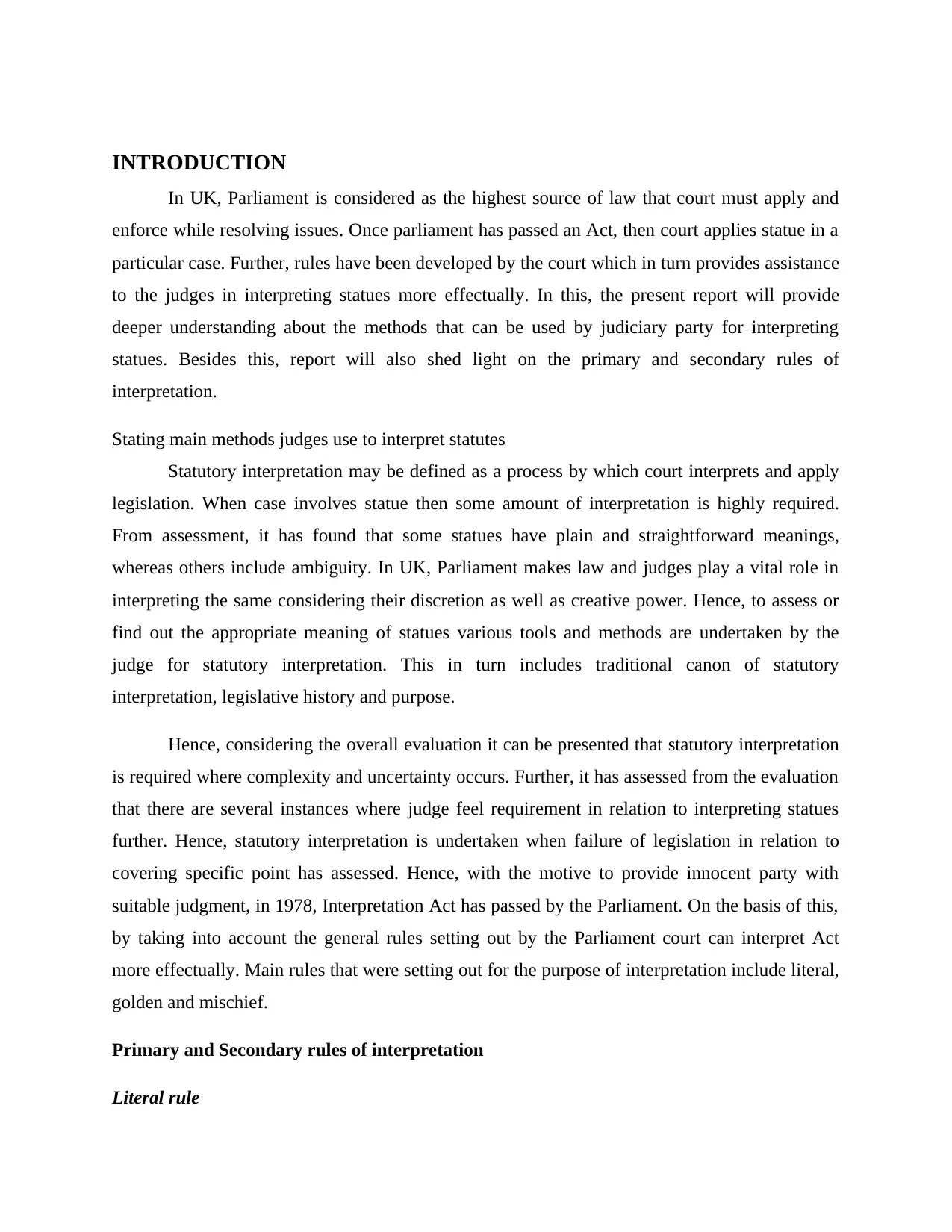
INTRODUCTION
In UK, Parliament is considered as the highest source of law that court must apply and
enforce while resolving issues. Once parliament has passed an Act, then court applies statue in a
particular case. Further, rules have been developed by the court which in turn provides assistance
to the judges in interpreting statues more effectually. In this, the present report will provide
deeper understanding about the methods that can be used by judiciary party for interpreting
statues. Besides this, report will also shed light on the primary and secondary rules of
interpretation.
Stating main methods judges use to interpret statutes
Statutory interpretation may be defined as a process by which court interprets and apply
legislation. When case involves statue then some amount of interpretation is highly required.
From assessment, it has found that some statues have plain and straightforward meanings,
whereas others include ambiguity. In UK, Parliament makes law and judges play a vital role in
interpreting the same considering their discretion as well as creative power. Hence, to assess or
find out the appropriate meaning of statues various tools and methods are undertaken by the
judge for statutory interpretation. This in turn includes traditional canon of statutory
interpretation, legislative history and purpose.
Hence, considering the overall evaluation it can be presented that statutory interpretation
is required where complexity and uncertainty occurs. Further, it has assessed from the evaluation
that there are several instances where judge feel requirement in relation to interpreting statues
further. Hence, statutory interpretation is undertaken when failure of legislation in relation to
covering specific point has assessed. Hence, with the motive to provide innocent party with
suitable judgment, in 1978, Interpretation Act has passed by the Parliament. On the basis of this,
by taking into account the general rules setting out by the Parliament court can interpret Act
more effectually. Main rules that were setting out for the purpose of interpretation include literal,
golden and mischief.
Primary and Secondary rules of interpretation
Literal rule
In UK, Parliament is considered as the highest source of law that court must apply and
enforce while resolving issues. Once parliament has passed an Act, then court applies statue in a
particular case. Further, rules have been developed by the court which in turn provides assistance
to the judges in interpreting statues more effectually. In this, the present report will provide
deeper understanding about the methods that can be used by judiciary party for interpreting
statues. Besides this, report will also shed light on the primary and secondary rules of
interpretation.
Stating main methods judges use to interpret statutes
Statutory interpretation may be defined as a process by which court interprets and apply
legislation. When case involves statue then some amount of interpretation is highly required.
From assessment, it has found that some statues have plain and straightforward meanings,
whereas others include ambiguity. In UK, Parliament makes law and judges play a vital role in
interpreting the same considering their discretion as well as creative power. Hence, to assess or
find out the appropriate meaning of statues various tools and methods are undertaken by the
judge for statutory interpretation. This in turn includes traditional canon of statutory
interpretation, legislative history and purpose.
Hence, considering the overall evaluation it can be presented that statutory interpretation
is required where complexity and uncertainty occurs. Further, it has assessed from the evaluation
that there are several instances where judge feel requirement in relation to interpreting statues
further. Hence, statutory interpretation is undertaken when failure of legislation in relation to
covering specific point has assessed. Hence, with the motive to provide innocent party with
suitable judgment, in 1978, Interpretation Act has passed by the Parliament. On the basis of this,
by taking into account the general rules setting out by the Parliament court can interpret Act
more effectually. Main rules that were setting out for the purpose of interpretation include literal,
golden and mischief.
Primary and Secondary rules of interpretation
Literal rule
⊘ This is a preview!⊘
Do you want full access?
Subscribe today to unlock all pages.

Trusted by 1+ million students worldwide
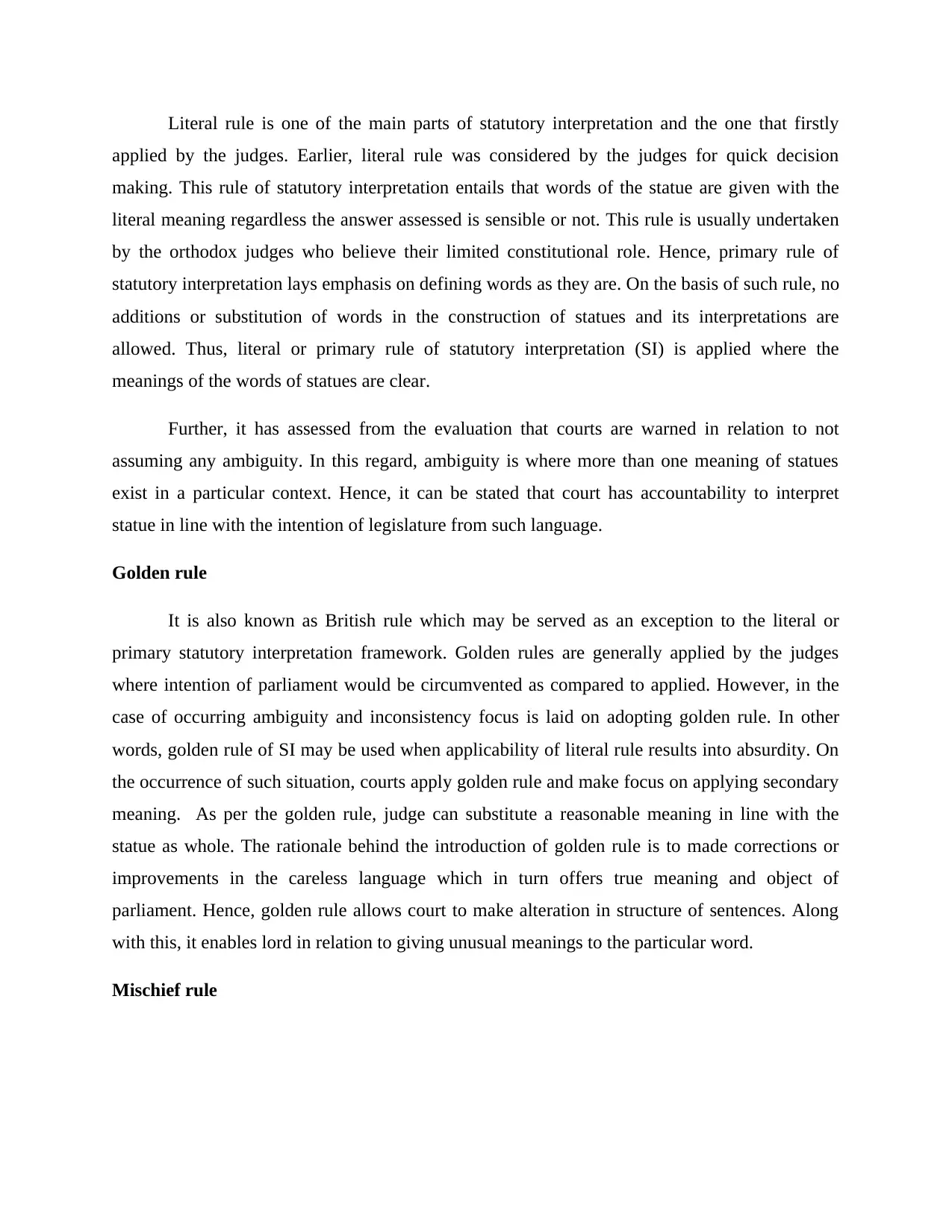
Literal rule is one of the main parts of statutory interpretation and the one that firstly
applied by the judges. Earlier, literal rule was considered by the judges for quick decision
making. This rule of statutory interpretation entails that words of the statue are given with the
literal meaning regardless the answer assessed is sensible or not. This rule is usually undertaken
by the orthodox judges who believe their limited constitutional role. Hence, primary rule of
statutory interpretation lays emphasis on defining words as they are. On the basis of such rule, no
additions or substitution of words in the construction of statues and its interpretations are
allowed. Thus, literal or primary rule of statutory interpretation (SI) is applied where the
meanings of the words of statues are clear.
Further, it has assessed from the evaluation that courts are warned in relation to not
assuming any ambiguity. In this regard, ambiguity is where more than one meaning of statues
exist in a particular context. Hence, it can be stated that court has accountability to interpret
statue in line with the intention of legislature from such language.
Golden rule
It is also known as British rule which may be served as an exception to the literal or
primary statutory interpretation framework. Golden rules are generally applied by the judges
where intention of parliament would be circumvented as compared to applied. However, in the
case of occurring ambiguity and inconsistency focus is laid on adopting golden rule. In other
words, golden rule of SI may be used when applicability of literal rule results into absurdity. On
the occurrence of such situation, courts apply golden rule and make focus on applying secondary
meaning. As per the golden rule, judge can substitute a reasonable meaning in line with the
statue as whole. The rationale behind the introduction of golden rule is to made corrections or
improvements in the careless language which in turn offers true meaning and object of
parliament. Hence, golden rule allows court to make alteration in structure of sentences. Along
with this, it enables lord in relation to giving unusual meanings to the particular word.
Mischief rule
applied by the judges. Earlier, literal rule was considered by the judges for quick decision
making. This rule of statutory interpretation entails that words of the statue are given with the
literal meaning regardless the answer assessed is sensible or not. This rule is usually undertaken
by the orthodox judges who believe their limited constitutional role. Hence, primary rule of
statutory interpretation lays emphasis on defining words as they are. On the basis of such rule, no
additions or substitution of words in the construction of statues and its interpretations are
allowed. Thus, literal or primary rule of statutory interpretation (SI) is applied where the
meanings of the words of statues are clear.
Further, it has assessed from the evaluation that courts are warned in relation to not
assuming any ambiguity. In this regard, ambiguity is where more than one meaning of statues
exist in a particular context. Hence, it can be stated that court has accountability to interpret
statue in line with the intention of legislature from such language.
Golden rule
It is also known as British rule which may be served as an exception to the literal or
primary statutory interpretation framework. Golden rules are generally applied by the judges
where intention of parliament would be circumvented as compared to applied. However, in the
case of occurring ambiguity and inconsistency focus is laid on adopting golden rule. In other
words, golden rule of SI may be used when applicability of literal rule results into absurdity. On
the occurrence of such situation, courts apply golden rule and make focus on applying secondary
meaning. As per the golden rule, judge can substitute a reasonable meaning in line with the
statue as whole. The rationale behind the introduction of golden rule is to made corrections or
improvements in the careless language which in turn offers true meaning and object of
parliament. Hence, golden rule allows court to make alteration in structure of sentences. Along
with this, it enables lord in relation to giving unusual meanings to the particular word.
Mischief rule
Paraphrase This Document
Need a fresh take? Get an instant paraphrase of this document with our AI Paraphraser
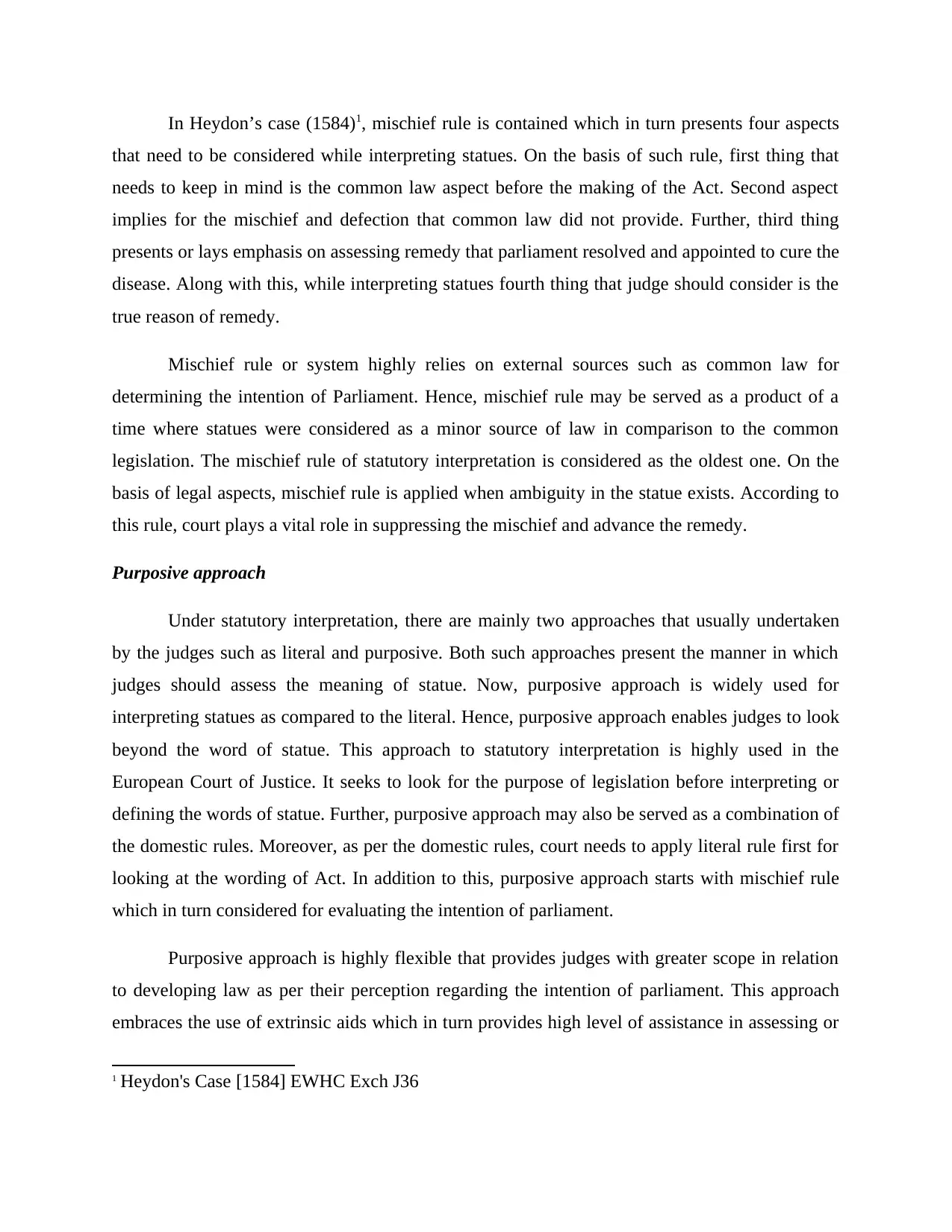
In Heydon’s case (1584)1, mischief rule is contained which in turn presents four aspects
that need to be considered while interpreting statues. On the basis of such rule, first thing that
needs to keep in mind is the common law aspect before the making of the Act. Second aspect
implies for the mischief and defection that common law did not provide. Further, third thing
presents or lays emphasis on assessing remedy that parliament resolved and appointed to cure the
disease. Along with this, while interpreting statues fourth thing that judge should consider is the
true reason of remedy.
Mischief rule or system highly relies on external sources such as common law for
determining the intention of Parliament. Hence, mischief rule may be served as a product of a
time where statues were considered as a minor source of law in comparison to the common
legislation. The mischief rule of statutory interpretation is considered as the oldest one. On the
basis of legal aspects, mischief rule is applied when ambiguity in the statue exists. According to
this rule, court plays a vital role in suppressing the mischief and advance the remedy.
Purposive approach
Under statutory interpretation, there are mainly two approaches that usually undertaken
by the judges such as literal and purposive. Both such approaches present the manner in which
judges should assess the meaning of statue. Now, purposive approach is widely used for
interpreting statues as compared to the literal. Hence, purposive approach enables judges to look
beyond the word of statue. This approach to statutory interpretation is highly used in the
European Court of Justice. It seeks to look for the purpose of legislation before interpreting or
defining the words of statue. Further, purposive approach may also be served as a combination of
the domestic rules. Moreover, as per the domestic rules, court needs to apply literal rule first for
looking at the wording of Act. In addition to this, purposive approach starts with mischief rule
which in turn considered for evaluating the intention of parliament.
Purposive approach is highly flexible that provides judges with greater scope in relation
to developing law as per their perception regarding the intention of parliament. This approach
embraces the use of extrinsic aids which in turn provides high level of assistance in assessing or
1 Heydon's Case [1584] EWHC Exch J36
that need to be considered while interpreting statues. On the basis of such rule, first thing that
needs to keep in mind is the common law aspect before the making of the Act. Second aspect
implies for the mischief and defection that common law did not provide. Further, third thing
presents or lays emphasis on assessing remedy that parliament resolved and appointed to cure the
disease. Along with this, while interpreting statues fourth thing that judge should consider is the
true reason of remedy.
Mischief rule or system highly relies on external sources such as common law for
determining the intention of Parliament. Hence, mischief rule may be served as a product of a
time where statues were considered as a minor source of law in comparison to the common
legislation. The mischief rule of statutory interpretation is considered as the oldest one. On the
basis of legal aspects, mischief rule is applied when ambiguity in the statue exists. According to
this rule, court plays a vital role in suppressing the mischief and advance the remedy.
Purposive approach
Under statutory interpretation, there are mainly two approaches that usually undertaken
by the judges such as literal and purposive. Both such approaches present the manner in which
judges should assess the meaning of statue. Now, purposive approach is widely used for
interpreting statues as compared to the literal. Hence, purposive approach enables judges to look
beyond the word of statue. This approach to statutory interpretation is highly used in the
European Court of Justice. It seeks to look for the purpose of legislation before interpreting or
defining the words of statue. Further, purposive approach may also be served as a combination of
the domestic rules. Moreover, as per the domestic rules, court needs to apply literal rule first for
looking at the wording of Act. In addition to this, purposive approach starts with mischief rule
which in turn considered for evaluating the intention of parliament.
Purposive approach is highly flexible that provides judges with greater scope in relation
to developing law as per their perception regarding the intention of parliament. This approach
embraces the use of extrinsic aids which in turn provides high level of assistance in assessing or
1 Heydon's Case [1584] EWHC Exch J36
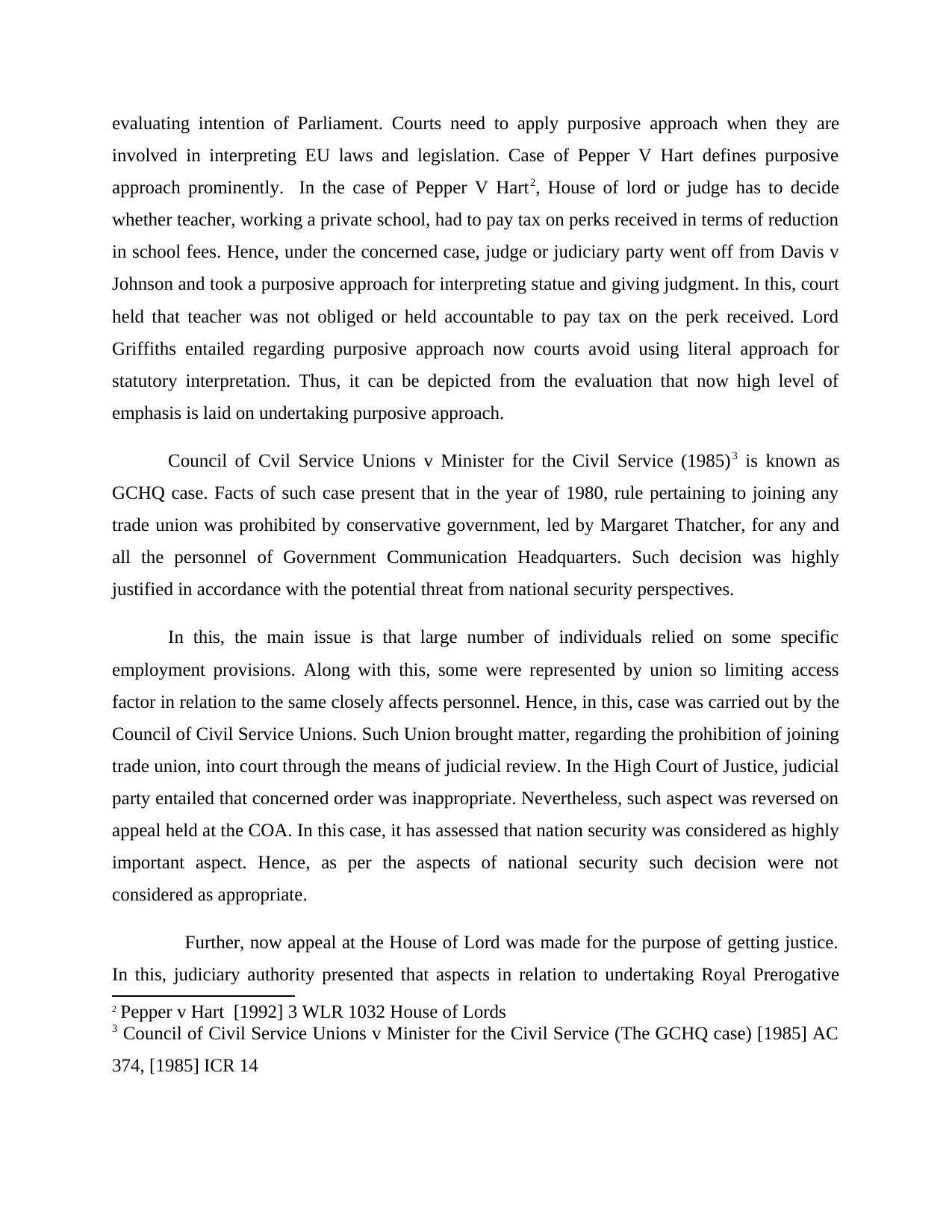
evaluating intention of Parliament. Courts need to apply purposive approach when they are
involved in interpreting EU laws and legislation. Case of Pepper V Hart defines purposive
approach prominently. In the case of Pepper V Hart2, House of lord or judge has to decide
whether teacher, working a private school, had to pay tax on perks received in terms of reduction
in school fees. Hence, under the concerned case, judge or judiciary party went off from Davis v
Johnson and took a purposive approach for interpreting statue and giving judgment. In this, court
held that teacher was not obliged or held accountable to pay tax on the perk received. Lord
Griffiths entailed regarding purposive approach now courts avoid using literal approach for
statutory interpretation. Thus, it can be depicted from the evaluation that now high level of
emphasis is laid on undertaking purposive approach.
Council of Cvil Service Unions v Minister for the Civil Service (1985)3 is known as
GCHQ case. Facts of such case present that in the year of 1980, rule pertaining to joining any
trade union was prohibited by conservative government, led by Margaret Thatcher, for any and
all the personnel of Government Communication Headquarters. Such decision was highly
justified in accordance with the potential threat from national security perspectives.
In this, the main issue is that large number of individuals relied on some specific
employment provisions. Along with this, some were represented by union so limiting access
factor in relation to the same closely affects personnel. Hence, in this, case was carried out by the
Council of Civil Service Unions. Such Union brought matter, regarding the prohibition of joining
trade union, into court through the means of judicial review. In the High Court of Justice, judicial
party entailed that concerned order was inappropriate. Nevertheless, such aspect was reversed on
appeal held at the COA. In this case, it has assessed that nation security was considered as highly
important aspect. Hence, as per the aspects of national security such decision were not
considered as appropriate.
Further, now appeal at the House of Lord was made for the purpose of getting justice.
In this, judiciary authority presented that aspects in relation to undertaking Royal Prerogative
2 Pepper v Hart [1992] 3 WLR 1032 House of Lords
3 Council of Civil Service Unions v Minister for the Civil Service (The GCHQ case) [1985] AC
374, [1985] ICR 14
involved in interpreting EU laws and legislation. Case of Pepper V Hart defines purposive
approach prominently. In the case of Pepper V Hart2, House of lord or judge has to decide
whether teacher, working a private school, had to pay tax on perks received in terms of reduction
in school fees. Hence, under the concerned case, judge or judiciary party went off from Davis v
Johnson and took a purposive approach for interpreting statue and giving judgment. In this, court
held that teacher was not obliged or held accountable to pay tax on the perk received. Lord
Griffiths entailed regarding purposive approach now courts avoid using literal approach for
statutory interpretation. Thus, it can be depicted from the evaluation that now high level of
emphasis is laid on undertaking purposive approach.
Council of Cvil Service Unions v Minister for the Civil Service (1985)3 is known as
GCHQ case. Facts of such case present that in the year of 1980, rule pertaining to joining any
trade union was prohibited by conservative government, led by Margaret Thatcher, for any and
all the personnel of Government Communication Headquarters. Such decision was highly
justified in accordance with the potential threat from national security perspectives.
In this, the main issue is that large number of individuals relied on some specific
employment provisions. Along with this, some were represented by union so limiting access
factor in relation to the same closely affects personnel. Hence, in this, case was carried out by the
Council of Civil Service Unions. Such Union brought matter, regarding the prohibition of joining
trade union, into court through the means of judicial review. In the High Court of Justice, judicial
party entailed that concerned order was inappropriate. Nevertheless, such aspect was reversed on
appeal held at the COA. In this case, it has assessed that nation security was considered as highly
important aspect. Hence, as per the aspects of national security such decision were not
considered as appropriate.
Further, now appeal at the House of Lord was made for the purpose of getting justice.
In this, judiciary authority presented that aspects in relation to undertaking Royal Prerogative
2 Pepper v Hart [1992] 3 WLR 1032 House of Lords
3 Council of Civil Service Unions v Minister for the Civil Service (The GCHQ case) [1985] AC
374, [1985] ICR 14
⊘ This is a preview!⊘
Do you want full access?
Subscribe today to unlock all pages.

Trusted by 1+ million students worldwide
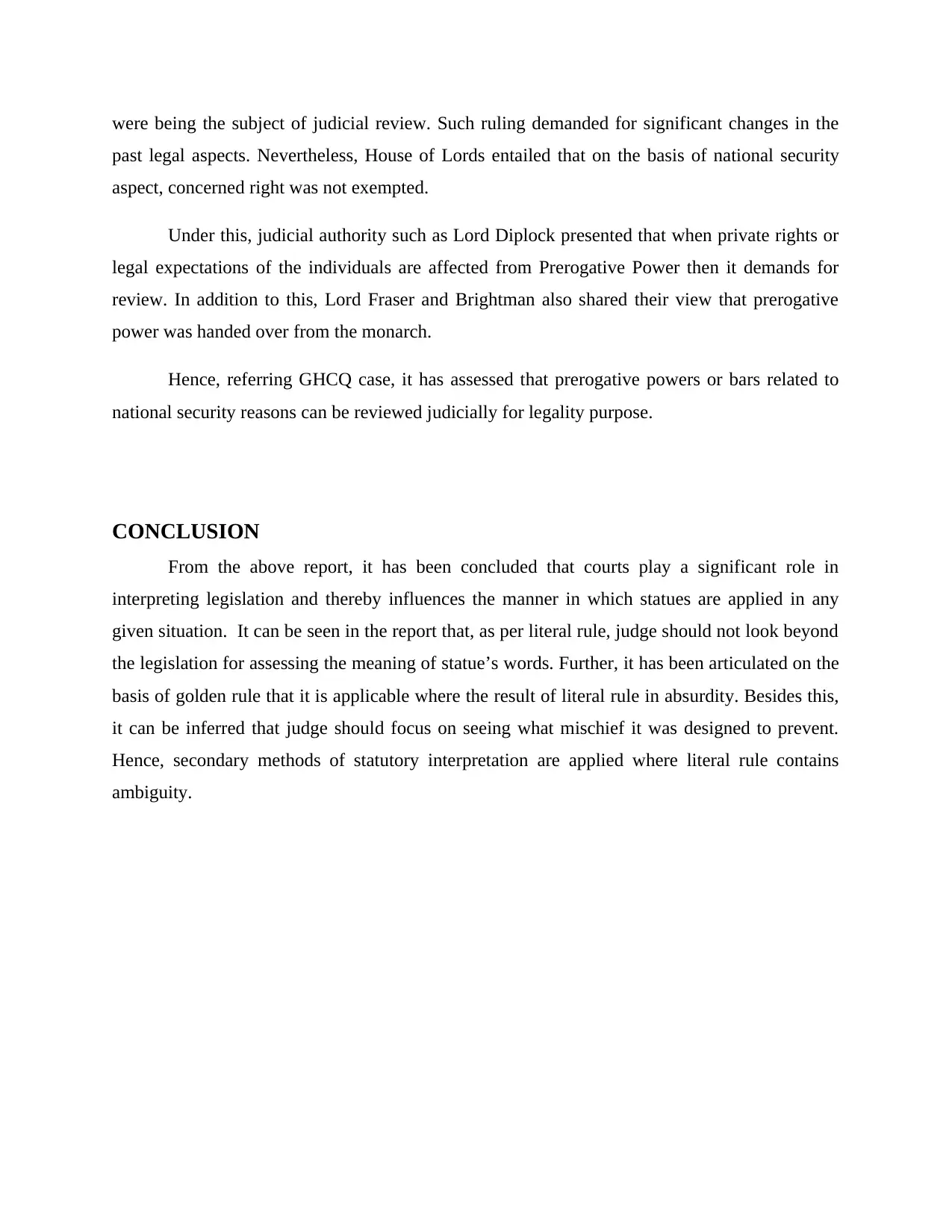
were being the subject of judicial review. Such ruling demanded for significant changes in the
past legal aspects. Nevertheless, House of Lords entailed that on the basis of national security
aspect, concerned right was not exempted.
Under this, judicial authority such as Lord Diplock presented that when private rights or
legal expectations of the individuals are affected from Prerogative Power then it demands for
review. In addition to this, Lord Fraser and Brightman also shared their view that prerogative
power was handed over from the monarch.
Hence, referring GHCQ case, it has assessed that prerogative powers or bars related to
national security reasons can be reviewed judicially for legality purpose.
CONCLUSION
From the above report, it has been concluded that courts play a significant role in
interpreting legislation and thereby influences the manner in which statues are applied in any
given situation. It can be seen in the report that, as per literal rule, judge should not look beyond
the legislation for assessing the meaning of statue’s words. Further, it has been articulated on the
basis of golden rule that it is applicable where the result of literal rule in absurdity. Besides this,
it can be inferred that judge should focus on seeing what mischief it was designed to prevent.
Hence, secondary methods of statutory interpretation are applied where literal rule contains
ambiguity.
past legal aspects. Nevertheless, House of Lords entailed that on the basis of national security
aspect, concerned right was not exempted.
Under this, judicial authority such as Lord Diplock presented that when private rights or
legal expectations of the individuals are affected from Prerogative Power then it demands for
review. In addition to this, Lord Fraser and Brightman also shared their view that prerogative
power was handed over from the monarch.
Hence, referring GHCQ case, it has assessed that prerogative powers or bars related to
national security reasons can be reviewed judicially for legality purpose.
CONCLUSION
From the above report, it has been concluded that courts play a significant role in
interpreting legislation and thereby influences the manner in which statues are applied in any
given situation. It can be seen in the report that, as per literal rule, judge should not look beyond
the legislation for assessing the meaning of statue’s words. Further, it has been articulated on the
basis of golden rule that it is applicable where the result of literal rule in absurdity. Besides this,
it can be inferred that judge should focus on seeing what mischief it was designed to prevent.
Hence, secondary methods of statutory interpretation are applied where literal rule contains
ambiguity.
Paraphrase This Document
Need a fresh take? Get an instant paraphrase of this document with our AI Paraphraser

1 out of 8
Related Documents
Your All-in-One AI-Powered Toolkit for Academic Success.
+13062052269
info@desklib.com
Available 24*7 on WhatsApp / Email
![[object Object]](/_next/static/media/star-bottom.7253800d.svg)
Unlock your academic potential
Copyright © 2020–2025 A2Z Services. All Rights Reserved. Developed and managed by ZUCOL.





